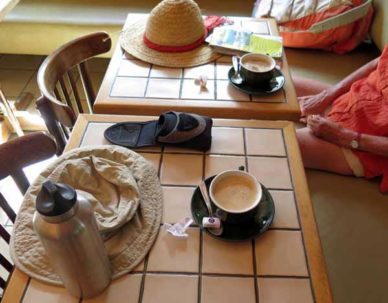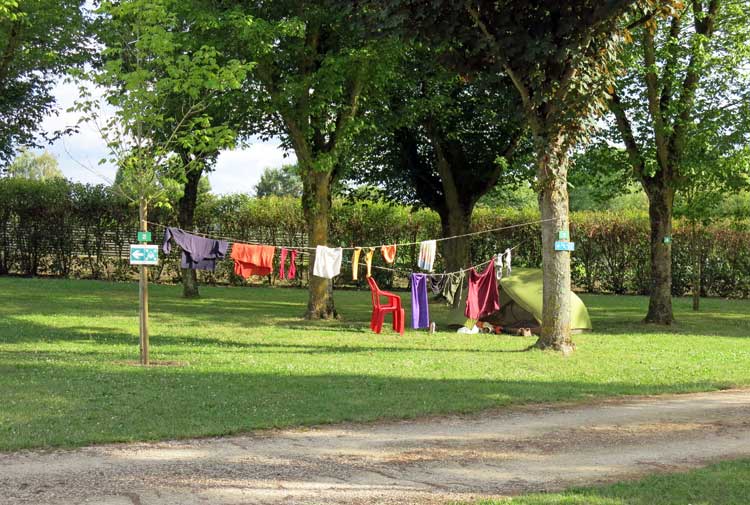
Monday, 14 July 2014
Distance 22 km
Duration 4 hours 20 minutes
Ascent 22 m, descent 19 m
Map 139 of the TOP100 lime-green series
When we crawled out in the morning, the sky was as clear as eggshell and the sun was gilding the tops of the trees. On the other hand, our grassy allotment was almost submerged and we had to carry everything up to a seat near the entrance to pack up. Sheets of water flew off the tent when we shook it.
It was a good feeling to leave this place where we had spent such a dreary Sunday afternoon.

We set off with optimistic tread through the deserted streets (it was Bastille Day), arriving in the main square about 7:30 am with the intention of having a proper caffein-rich French breakfast, but nothing was open except a couple of boulangeries. Not for the first time, we cursed the French National Day.
Then we noticed that one of the boulangeries had a coffee machine. As in Vouneuil the day before, we were saved by the enterprise of the baker, who had also put a few tables out in the alley. We sat there with our plastic mugs of café au lait and some deliciously light pastries, thinking ourselves the luckiest people in the world.

After this good start we strode out of town on the main road, picking up the GR in the industrial area to the north.
Past an enormous roundabout, the GR turned off and crossed the TGV line onto a quiet country lane spotted with drying puddles.
Long morning shadows hung over fields of sunflowers and wheat and we felt very happy to be doing what we were doing.
At the turn-off to Ingrandes, we kept going on the GR, but soon afterwards parted company with it as it rose towards the château of St-Ustre.

We continued along the D161 which stayed close to the TGV line, and had the pleasure of seeing a couple of these marvellous silver bullets streaking past.


At the base of the village of St-Ustre we stopped to apply sun-cream – it was the first time for days that we had needed it. Looking uphill, we could see the arched entrance leading to the château of grateful memory, where we had found refuge on a previous walk.
When we set off again, I managed to leave my spectacles lying in the grass, but I realised after half a kilometre and galloped back to retrieve them, while Keith minded my pack under the puzzled gaze of a villager working in his garden.

We walked on across flat, orderly farmland until we came to a fork in the road, where we veered off to cross over the TGV line and enter Dangé-St-Romain, the biggest village on this stretch of the river.
At the entry there was a massive Carrefour supermarket doing brisk trade. It was open until 12:30 pm and we took the chance to lay in a tomato, a sausage and half a baguette for our lunch. We hoped that the restaurant at les Ormes would be open in the evening, but if not we would lunch there instead, and have the bread and sausage in the evening.

The town itself was a surprising distance along the main road and when we arrived it was all closed for Bastille Day except for a Logis hotel, whose front bar was open but empty. There did not seem to be much festive spirit among the loyal citizens of this town.
We sat down gratefully while the barwoman prepared our large, hot, delicious coffees, chatting all the while.
When we said that we were going to les Ormes, she said that there was nothing there at all, but we did not believe her, as we had visited the restaurant a few years ago while walking the Way of Tours. She also told us that the rainy weather was over, but would return on Friday.
Our main worry was that the camping ground at les Ormes might be closed. According to the barwoman’s dark predictions, it would be, but we decided to risk it. There was a small farm road beside the highway which delivered us to the streets of les Ormes in an hour, and we soon found the camping ground, with its gates wide open and everything fresh and well-tended.
We booked ourselves in and asked the woman about the possibilities for dinner in this village, only to to be told that the restaurant had died years ago, and that both the boulangerie and the épicerie would close at 12:30 and not reopen, because it was Bastille Day.

It was not quite 12:30, so we left our packs with the obliging woman and rushed into the village but in vain – it was as dead as the traditional doornail. The restaurant on the highway that we remembered was an empty wreck, with a mouldering sign and paint peeling from the walls.
Further along there was a new hotel-restaurant-bar (le Relais du Cheval Blanc) which raised our hopes momentarily, but the door was shut and our knocking went unanswered.
Across the road was a closed boulangerie that was also a café, and presumably would have been open any day of the year except this one.

Nevertheless, we told ourselves that we had a pleasant place to camp, enough food to keep hunger at bay (although no wine), and on top of that, the weather was now sunny and warm and there was no bellowing Algerian madman in the camping ground, as far as we knew.
We went back, put up the tent in a grove of trees, and had lunch in a sort of gazebo in the grounds. There were several other families in residence, all in elephantine vans and all French.
Then we washed ourselves and our clothes, although the showers were rather cool. I even washed my warm top, stiff with sweat, for the first time on the trip.

Later we walked back to explore the village, which was quite charming, with a maze of crooked lanes and a couple of squares.
The church steeple had a slender Oriental dome which gleamed in the afternoon sun, and at its feet stood an ancient market hall in the process of being restored.
The formidable wall of the château of les Ormes stood at one side. The other square contained the Mairie and had gardens and seats, as well as a boules court where people were playing.
Around the perimeter were a Vival supermarket and a bar, both closed. We also found a second boulangerie but needless to say, it was closed too.

On our way back to the camping ground we strolled onto the bridge and looked down at our old friend the Vienne sliding calmly along beneath our feet.
We hoped that the following evening we would be beside it again, but in more lively and satisfying surroundings. It was not the fault of the village that we were there during the annual fit of patriotic zeal.
We had borrowed a couple of plastic chairs from the gazebo so we sat in comfort to eat the remains of our lunch food. It could hardly be called dinner, but things could have been worse, and frequently had been in the past.
Previous section: Lussac-les-Châteaux to Châtellerault